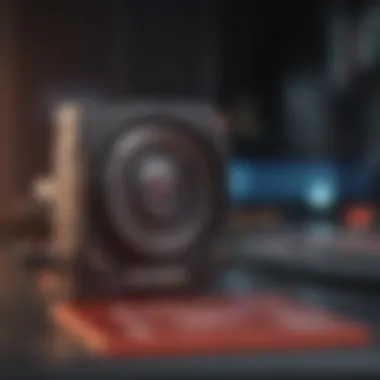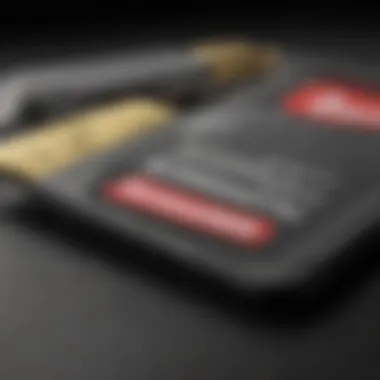Optimal SD Card Speeds for Enhanced Gaming Performance


Intro
When it comes to gaming, every detail plays a key role in the overall experience. One area often overlooked is the speed of the SD card. This isn’t just about storage capacity; the speed at which data is read and written can greatly impact how smoothly games run, especially on Nintendo consoles.
With the evolution of gaming technology, understanding SD card classifications becomes crucial for maximizing gameplay. The world of SD cards is filled with various options, and picking the right one can feel like finding a needle in a haystack. To help navigate this, we’ll explore the significance of SD card speed,
• What these speed classifications mean in practice, • Their influence on game performance, • Real-life tips for selecting the ideal SD card for your gaming needs.
The right choices can enhance the overall efficiency of your gaming setup and make a world of difference to how you enjoy your Nintendo gaming experience.
"A slow SD card can be the invisible enemy that sabotages your game immersion, taking you out of the virtual world, just when you are enjoying the action."
In this article, we will dive into the nuts and bolts of SD card speeds. By the end, you will be better equipped to understand which card suits your gaming style and why it matters. Let's kick things off with a breakdown of speed classifications.
Preamble to SD Card Speed
In the world of gaming, not having the right tools can really feel like trying to drive a car with square wheels. That’s where the importance of SD card speed comes into play. As gaming becomes more immersive and demanding, selecting the right SD card isn’t just a matter of storage; it has significant implications on performance and experience.
When you pop that SD card into your console, you expect everything to run smoothly—whether it’s loading the next level of your favorite game or saving your hard-earned progress. Understanding SD card speed means familiarity with how it affects playability, loading times, and general enjoyment. It's a fine balance between storage capacity and speed, each playing a pivotal role in your gaming journey.
The nuances of SD card classifications can seem daunting at first glance, but breaking them down reveals critical insights. SD cards are not all made equal. Some are built for speed, while others focus on storage space. This article dives into these classifications and examines their real-world relevance in gaming. By unraveling this complexity, the goal is clear: to give you a toolkit for choosing an SD card that not only meets your needs but enhances your gaming experience.
The Role of SD Cards in Gaming
Games today are often massive in terms of both graphical fidelity and file size. An SD card's role in this context is multifaceted. Firstly, it acts as a reservoir for game data, ensuring that the console has enough space to function efficiently. If you're a gamer who loves variety, your library is likely diverse, requiring ample storage.
However, it’s more than just storage. The speed of an SD card determines how fast a console can read and write data. Imagine the frustration of waiting while a game loads, or worse, experiencing stutters during a pivotal moment simply because the SD card can’t keep up. Fast cards allow for rapid access to game saves and online features, providing a seamless experience.
- Faster loading times mean you can jump straight into the action.
- Better responsiveness can lead to improved gameplay, especially in competitive scenes.
- Reliability ensures that your game saves and media are secure, eliminating the panic that comes with potential corruption.
In short, SD cards are not just external memory; they are key players in the whole gaming experience, shaping how easily and quickly you interact with your favorite titles. Keeping all this in mind prepares you to better understand what lies ahead in the subsequent sections.
Understanding SD Card Classifications
Understanding SD card classifications is pivotal for any gamer who seeks to maximize their experience, especially when it comes to Nintendo consoles. It’s not just about having an SD card; it’s about choosing the right one that aligns with your gaming habits and needs. With various speed classifications, it can be rather confusing for the typical user to navigate through the options. Hence, grasping these classifications can greatly influence your gameplay, loading times, and overall satisfaction. This section aims to clarify the specific speed classes, helping you make an informed decision that enhances your gaming potential.
Speed Class Ratings Explained
Speed class ratings are essentially indicators of minimum write speeds, which directly correlate with how efficiently an SD card can handle data. The scheme is quite straightforward but misunderstood at times. Here are the main class ratings:
- Class 2: Minimum write speed of 2 MB/s. Suitable for basic applications.
- Class 4: Minimum write speed of 4 MB/s; more appropriate for standard video recording.
- Class 6: Minimum write speed of 6 MB/s; decent for HD video.
- Class 10: Minimum write speed of 10 MB/s; meets most gaming needs.
Gaming on a Nintendo console typically roams the realm of Class 10 or higher, ensuring that your games load seamlessly without any unwanted pauses or buffering. Therefore, selecting an SD card with at least a Class 10 rating is essential if you want to avoid any hiccups while exploring the vast worlds of your favorite games.
UHS Speed Classes
UHS, or Ultra High Speed, classifiers are the next step up from basic speed ratings. These classes provide a broader spectrum of speed to accommodate more demanding applications, particularly in gaming, where every second counts. UHS ratings come in two primary classes:
- UHS-I: Offers a bus interface speed of up to 104 MB/s.
- UHS-II: An advancement allowing speeds up to 312 MB/s.
The UHS class is especially relevant for gamers wanting to push the limits of their console. If you plan to download games frequently or engage in data-heavy activities, investing in a UHS-I or UHS-II card will make a noticeable difference. It’s like getting an express pass at an amusement park; you combat long waiting times and get right to the fun.
Video Speed Classes and Their Relevance


Video speed classes (V30, V60, and V90) serve a specific purpose—primarily in video recording. However, they also hold significant sway in gaming performance. Here's a breakdown:
- V30: Guarantees a minimum write speed of 30 MB/s.
- V60: Guarantees a minimum of 60 MB/s, catering to higher resolution footage.
- V90: At 90 MB/s, it's tailored for the most demanding video tasks.
These classes become relevant for gamers, especially when installing vast open-world games that require data to be read swiftly to avoid lags. When a game demands quick data loads and includes high-resolution textures, the necessity for a higher video speed class grows much clearer.
As a general rule of thumb, the faster the SD card speed, the better the gaming experience, particularly in load times and responsiveness.
Choosing the right class not only impacts your current gaming setup but also positions you wisely for future titles that may demand even more from your hardware. Don’t just think about what fits today; consider what you might be playing tomorrow.
Impacts of SD Card Speed on Gaming Performance
When talking about gaming on Nintendo consoles, many gamers often overlook a crucial component: the speed of their SD cards. The impacts of SD card speed can be significant; they’re more than just numbers on a label. They play an essential role in how smoothly games run, how quickly they load, and even how satisfying your gaming experience is overall. Let’s dive into a few specific factors to consider.
Loading Times and Game Responsiveness
In the world of gaming, every second counts. Imagine you're diving into a new adventure, but instead of jumping right in, you're staring at a loading screen feeling as if time is crawling. Fast SD cards can help minimize that frustration. When your SD card can read and write data quickly, game assets load more efficiently. This means you’re not left twiddling your thumbs while waiting for the latest world to appear.
For instance, a game like The Legend of Zelda: Breath of the Wild can be greatly enhanced if your SD card has adequate speed. Often, players have noted that higher-speed cards allow for quicker transitions when fast traveling or entering new zones. This doesn't just make the game feel smoother; it keeps immersion intact.
Furthermore, responsive gameplay ensures you enjoy every second of your adventure, making it that much more enjoyable. Consider the phrase "time flies when you're having fun"; that couldn't be truer in gaming, and faster loading times certainly contribute to that.
Impact on Download and Install Speeds
With many games available for download directly to a console, the speed of your SD card has a direct effect on how long it takes to get into gameplay. When downloading and installing new games, a faster SD card enables swifter speeds, which is all the more essential when there’s a hot title on the market that everyone’s buzzing about.
This is particularly relevant when developers release large patches or updates. A slow card can turn what might be an exciting evening of gaming into a tedious waiting game. Additionally, if you're racing against friends or the clock to try a new game, having a speedy SD card could give you the competitive edge needed to be the first to dive in. It all boils down to gearing up for an engaging experience instead of waiting.
The Role of Write Speeds in Gaming
While read speeds often take center stage, write speeds are equally important, especially for gamers who love saving their progress often or enjoy recording gameplay sessions. A higher write speed can dramatically affect how quickly you save your game, upload clips, or even deal with games that rely heavily on writing data — think of games that continuously save your state or have a lot of real-time multiplayer elements.
If a card struggles on the write end, you might encounter slowdowns during crucial moments. Have you ever sat there watching the game save, praying it doesn’t crash? Frustrating, right? That's precisely where a high-class SD card can shine. In the heat of an epic battle or an intense racing moment, the last thing you want is to face delays caused by writing data.
In summary, the right SD card speed can be the difference between a solid gaming experience and a choppy, frustrating one. The smoothness of loading times, the swiftness of downloads and installs, and the efficiency of write speeds all blend together to sculpt the nature of your overall gameplay experience on Nintendo consoles.
Choosing the Right SD Card Speed for Nintendo Consoles
When it comes to enhancing your gaming adventure on Nintendo consoles like the Switch, the SD card you choose can make all the difference. Players often overlook the importance of the speed rating of their SD cards, but it can profoundly affect the overall experience. In fast-paced gaming scenarios, lagging or loading issues can be painfully disruptive. Thus, choosing the right SD card speed is not just a matter of performance; it shapes how seamlessly you dive into your favorite virtual worlds.
There are certain aspects that gamers need to consider when picking an SD card for their Nintendo Switch. Key among these factors is the card's reading and writing speeds. Higher speeds generally mean quicker loading times for games, while also facilitating smoother gameplay, especially for larger, more complex titles.
Here are a few benefits to consider:
- Faster Loading Times: A high-speed SD card minimizes wait time when starting a game or loading a new stage.
- Improved Game Responsiveness: In-game operations are streamlined, allowing smoother control actions and quicker responses.
- Future-Proofing: With advancements in game design, opting for faster cards can prepare you for upcoming titles with heavy resource demands.
Consideration of SD card speed is also vital in maintaining an optimal level of performance across a library of games.
"An SD card isn't just storage; it's your gaming lifeline. Choose wisely!"
Overall, selecting the right SD card speed directly influences gameplay enjoyment and functionality.
SD Card Recommendations for Nintendo Switch
When looking at SD card recommendations for the Nintendo Switch, several models stand out due to their reliability, speed, and compatibility. Some notable ones include:


- SanDisk Ultra: This card typically boasts rapid read speeds, making it a favorite for many users.
- Samsung EVO Select: Known for its high performance in both read and write operations, making it suitable for resource-heavy games.
- Lexar Play: Features a design focused on gaming, often equipped with both capacity and speed that many players appreciate.
Each of these cards has received good feedback from the gaming community for their speed capabilities, balancing performance and price effectively. Prior to making a decision, checking current user reviews can also provide additional insights into a card's performance in real-world conditions.
Considering Future Game Titles
The landscape of gaming is continually evolving, with new titles stretching the capacities of available hardware. It's wise to keep in mind that while the current games may run smoothly on a mid-range SD card, newer releases may demand more speed and responsiveness from storage solutions.
Gaming developers are increasingly exploring advanced graphics and gameplay mechanics, which often results in larger game files. In fact, as consoles advance, new titles are frequently designed with the intention of utilizing high-speed storage systems. Therefore, investing in an SD card with a higher speed classification can be seen as preparing for what’s ahead in the gaming realm.
Things to ponder:
- Game File Sizes: Consider the size of potential future game titles you anticipate playing.
- Performance in Demanding Scenarios: Think about whether you will be playing competitive or fast-paced games that require quick load times.
- Updates and Download Requirements: Regular updates for games can introduce additional space and speed requirements.
In summary, by choosing an SD card that balances current needs with future demands, you can ensure a more sustained and enjoyable gaming experience on your Nintendo console.
Comparative Analysis of Popular SD Cards
The ever-evolving landscape of game technology necessitates a careful examination of the myriad options available for SD cards. Understanding the comparative analysis of popular SD cards is crucial for gamers keen on optimizing their consoles’ performance. This section aims to uncover what distinguishes the top contenders in SD card technology, focusing on their features, reliability, and suitability for various gaming needs. A deep dive into this topic reveals how informed choices can greatly enhance the gaming experience, ultimately leading to joyful hours of uninterrupted play.
Top Brands in SD Card Technology
When it comes to SD cards, several brands consistenty rise above the competition, not just by throwing their names around but by delivering performance that gamers can rely on. SanDisk, Samsung, Lexar, and Kingston are some of the most recognizable names in the game. Each of these brands has carved out a niche in the gaming community for different reasons:
- SanDisk: Known for producing reliable SD cards with competitive speeds. Their products often include specially designed cards for gaming, which perform exceptionally with Nintendo consoles.
- Samsung: They have made a big splash with their Evo Select line, offering high capacities and robust speeds, ideal for demanding loads that gaming requires.
- Lexar: While not as frequently mentioned, Lexar has garnered a loyal fanbase, particularly with their Professional line, which promises impressive read and write speeds.
- Kingston: Renowned for durability and reliability, Kingston’s cards are ideal for extensive game libraries and high storage needs.
Each of these brands offers a unique advantage, making them worthy of consideration when choosing an SD card for gaming.
Performance Benchmarks of Leading Models
Understanding performance benchmarks can be a game-changer (pun intended) when selecting the right SD card. The differences between various models may not initially seem vast, yet they can have significant consequences for gameplay. Below are key factors to consider:
- Read and Write Speeds: These metrics indicate how quickly data can be accessed from and written to the card. A card with higher speeds reduces loading times and improves game responsiveness - crucial for live-action gameplay.
- Durability and Temperature Resistance: Some models are engineered to withstand higher levels of physical stress and temperature fluctuations, an important consideration for active or portable gaming scenarios. Cards like the SanDisk Extreme series excel in these areas.
- Capacity vs. Speed: Higher capacity cards come with the trade-off of potential speed variance. Some gamers may choose larger storage options while sacrificing optimal speed, which can affect performance in the heat of action. Cards such as the Samsung EVO Plus provide a good balance between speed and capacity, making them a hot choice among gamers.
"When diving into the world of SD cards, remember: it's not just about how much you can store, but how efficiently you can access that data."
Storage Capacity vs. Speed
When it comes to gaming on Nintendo consoles, striking a balance between storage capacity and speed can feel like walking a tightrope. The truth is, both aspects are crucial, but they serve different purposes in enhancing the gaming experience. Understanding how they interplay can make a significant difference in how smoothly your games run.
First, let's tackle storage capacity. This refers to how much data the SD card can hold. More storage means you can jam-pack your console with games, save files, downloadable content, and much more. For avid gamers, having enough room is key because the size of modern games can be quite hefty, often reaching tens of gigabytes. Imagine wanting to download the newest installment of a beloved franchise, only to find out your card's full—frustrating, right? It's a bit like having a massive bookshelf but running out of space for that latest book you’ve been eying.
On the flip side, there's speed. An SD card with higher speeds enables quicker data transfer. This translates to faster loading times in games, smoother gameplay, and an overall snappier user experience. Think of it as a well-oiled machine that responds swiftly when you push the pedal. If you opt for a card that only has decent capacity but lower speed, you might be able to store all your games, yet endure long loading screens that sap the joy out of them. Nobody wants that when they’re itching to jump into action.
Here’s the kicker: listing out your priorities based on your gaming habits is essential. If you’re a casual player who dabbles in different titles but doesn’t play them often, you might prefer an SD card with more storage, as it allows for a variety of game options. Meanwhile, if you are a serious gamer who plays competitive titles and expects quick match-ups, then speed becomes the hero of your story.
To help visualize this balance:
- For Storage:
- For Speed:
- Larger SD cards (e.g., 256GB and above) are ideal for keeping your collection expansive.
- Consider regularly installed games; you wouldn’t want to delete them every time a new one comes out.
- Go for UHS-I or UHS-II SD cards for optimal performance—these classes offer significantly better speeds.
- Look out for cards with a write speed above 90 MB/s if you often download large game updates.


It's crucial to evaluate your specific gaming needs—are you hoarding a library of classics, or do you prefer to stick with a few favorites that demand performance?
Ultimately, when choosing your SD card, think about your gaming habits and what matters most to you: having a variety at your fingertips or enjoying a seamless, lag-free experience. There's no one-size-fits-all answer, but assessing these factors will guide you toward making a wise selection when it comes to SD card shopping.
Potential Issues with SD Cards
As much as SD cards can enhance gaming experiences, they’re not without their share of potential problems. Understanding these issues is crucial for gamers, especially those using Nintendo consoles. This section addresses common challenges that users might encounter and offers insights on how to tackle them effectively.
Common Problems Faced by Users
SD cards can be a double-edged sword; they provide the storage necessary for our games but can also bring about unexpected headaches. Here’s a rundown of typical issues:
- Compatibility Issues: Not all SD cards are created equal. Users often find that a card may be incompatible with their gaming console, leading to frustration and wasted time.
- Corruption of Data: Nobody wants to face corrupted save files. SD cards can sometimes fail, whether due to manufacturer defects or mishandling, putting your game progress at risk.
- Slow Read/Write Speeds: Imagine waiting to load into your favorite game or, worse, facing stutters because the card is dragging its feet. Not all SD cards maintain high speeds consistently, impacting overall performance.
“Choosing an appropriate SD card is more than just picking a high capacity. Speed and compatibility can make or break your gaming experience.”
It’s these concerns that compel users to be vigilant when selecting SD cards for gaming. Awareness of these potential hiccups can save a gamer from a world of hurt.
Mitigating Slow Speeds and Corruption Risks
Avoiding disappointments with SD cards might seem daunting but there are practical approaches to minimize speed issues and data corruption risks.
- Prioritize Quality Brands: Opt for reputable producers like SanDisk or Samsung. These brands might be costlier but often guarantee better performance and reliability.
- Regular Backups: It’s wise to back up your game saves regularly. Utilizing cloud saves where possible can help recover lost files should an SD card fail.
- Conduct Speed Tests: Before committing, running a speed test using tools like CrystalDiskMark can provide a clear understanding of the card’s read and write capabilities.
- Formatted Properly: Formatting the card before first use can prevent future issues, ensuring it’s tailored for the specific console.
- Avoid Overfilling: Keeping some space free on your SD card can enhance performance. Too many files can slow down read and write speeds.
In the end, being proactive can drastically improve the experience, letting you focus on what matters most – gaming.
Future Trends in SD Card Technology
As gaming technology progresses at an unrelenting pace, understanding the future trajectories of SD card technology becomes increasingly crucial. The demands of modern gaming, especially on platforms like Nintendo's consoles, continue to rise, necessitating faster read and write speeds, along with greater storage capacities. This section digs into how upcoming trends can affect gamer experiences and what considerations should influence future purchases.
Advancements in Speed and Capacity
The advent of new technologies in SD card design is driving improvements in both speed and storage capacity, thereby directly influencing gaming performance. One significant advancement to watch is the emergence of SD cards that support the latest UHS (Ultra High Speed) specifications. These cards offer remarkable data transfer rates, often exceeding 300 MB/s, which translates to quicker game loading times and smoother gameplay.
Here are some noteworthy elements to consider regarding speed and capacity advancements:
- Increased Data Throughput: Devices are being designed to leverage high-speed SD cards, reducing latency and enhancing gameplay fluidity. With ultra-high speeds, gamers can enjoy extensive game libraries without frustrating delays.
- Larger Storage Options: The rise of 1TB and larger SD cards is becoming commonplace. This expands the amount of content gamers can store without having to frequently swap out cards, creating a more seamless gaming experience.
- Emerging Formats: Newer SD card formats, such as SD Express, are making waves by utilizing PCIe and NVMe interfaces, promising dramatically higher speeds and improved performance over older standards. This shift can revolutionize how games are loaded and played.
The implications of these changes are profound. For instance, imagine a world where texture popping and level streaming issues are virtually eliminated, allowing you to lose yourself in expansive game worlds. The speed advancements not only benefit storage but enhance overall gameplay.
"As technology evolves, the lines between hardware limitations and immersive experiences continue to blur."
Gamers should also keep an eye on the compatibility of upcoming SD card technologies with current consoles. Not every new card will work seamlessly with older devices, and understanding this is crucial to avoid investing in a card that won't be utilized effectively.
Finale
In the grand tapestry of gaming, the speed of your SD card plays a pivotal role, especially for those who are devoted to Nintendo consoles. It's more than just a storage medium; it directly affects how seamlessly games load and how fluidly they run. A card that lags behind in speed can easily spoil the experience, introducing delays that can frustrate even the most patient players.
When considering the ideal speed for an SD card, there are specific elements that deserve close attention. First, understanding the various classifications of SD cards—such as Speed Class and UHS (Ultra High Speed) ratings—allows gamers to make more informed choices tailored to their particular gaming styles. Investing in a card with a higher write speed can lead to faster installations and smoother gameplay, especially for data-intensive games.
Secondly, it’s important to consider future game titles. Many modern games are designed with sprawling worlds and large asset files, engaging experiences that can demand more from your storage than games of yore. Thus, opting for a high-speed SD card isn’t just a choice; it’s a necessity for anyone aiming to optimize their gaming setup.
"A poor choice in SD card can turn a thrilling gaming session into an exercise in patience."
Furthermore, evaluating brands and specific card models can reveal distinctions in performance that may not be obvious at first glance. Even among high-rated cards, performance can vary based on real-world usage and conditions.
Lastly, understanding potential issues such as data corruption and speeds that fall short of expectations can empower gamers to choose wisely. Mitigating these risks not only prolongs the lifespan of the SD card but also protects the integrity of game saves and data.
In summary, making an educated choice about the speed of your SD card holds immense benefits, paving the way for a satisfying and uninterrupted gaming experience. As technology continues to advance, staying informed and adaptable will ensure that fans can enjoy their favorite Nintendo games without the hindrance of slow loading times or other technical setbacks. By weighing all these considerations and choosing the right card, you're not just investing in storage, but in an optimized gaming experience.



